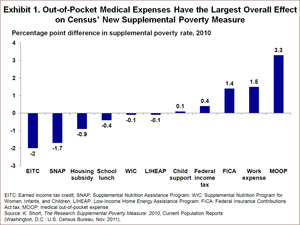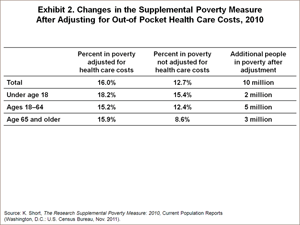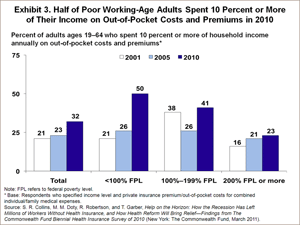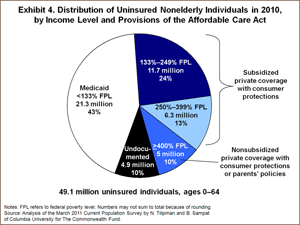A new report released this week by the U.S. Census Bureau finds that the growing burden of health care costs in family budgets is impoverishing millions of U.S. families. Using an experimental "supplemental poverty measure," that adjusts income for in-kind income transfers like food stamps as well as significant costs such as payroll taxes, the report shows that if health care costs were subtracted from family incomes, 10 million more people in the United States would be officially poor.
 This new estimate of the effect of health care costs and other factors on poverty is the culmination of a 16-year effort by the Census Bureau to develop a measure of poverty that is more reflective of families' actual income and expenses. Exhibit 1 shows the effects of these adjustments on the new measure, with policies like the Earned Income Tax Credit reducing poverty rates, and work-related expenses such as child care increasing poverty rates. The net effect of all the new dimensions in the measure is an increase in the national poverty rate to 16.0 percent in 2010 compared with the official poverty rate of 15.2 percent. Poverty among children actually declines with the new measure, with the Earned Income Tax Credit, food stamps, and the school lunch program particularly benefiting young people in poor families.
This new estimate of the effect of health care costs and other factors on poverty is the culmination of a 16-year effort by the Census Bureau to develop a measure of poverty that is more reflective of families' actual income and expenses. Exhibit 1 shows the effects of these adjustments on the new measure, with policies like the Earned Income Tax Credit reducing poverty rates, and work-related expenses such as child care increasing poverty rates. The net effect of all the new dimensions in the measure is an increase in the national poverty rate to 16.0 percent in 2010 compared with the official poverty rate of 15.2 percent. Poverty among children actually declines with the new measure, with the Earned Income Tax Credit, food stamps, and the school lunch program particularly benefiting young people in poor families.
But of all the new dimensions in the supplemental poverty measure, out-of-pocket health care spending has the greatest overall effect on poverty. When family incomes are adjusted for out-of-pocket medical costs, the national poverty rate as measured by the new supplemental measure increases by 3.3 percentage points, or about 10 million people (Exhibit 2). Poverty increases across all age groups after subtracting medical costs from income, with 2 million more children, 5 million more working-age adults ages 18 to 64, and 3 million more adults age 65 and older falling below the poverty threshold. The effect on older adults, who have the highest rates of chronic health problems, is particularly severe, with the estimated poverty rate rising by more than seven percentage points.
This finding provides evidence that health care costs have become one of the most significant living expenses faced by poor families. In a recent report, The Commonwealth Fund found that in 2010 fully half of working-age adults with incomes below poverty spent 10 percent or more of their income on out-of-pocket health care costs and insurance premiums, which is more than double the percentage of those who spent that much in 2001 (Exhibit 3).
 The Census report is a reminder of the critical importance of our key federal and state health insurance programs like Medicare, Medicaid, and the Children's Health Insurance Program in not only providing timely access to health care, but in keeping millions of U.S. families from tumbling over the poverty line. Starting in 2014, the Affordable Care Act will expand these protections to up to 34 million more people over the decade through an expansion in Medicaid eligibility to 133 percent of poverty. For families earning up to 400 percent of poverty, the Affordable Care Act also includes premium tax credits than will cap the cost of health plans—sold through new state insurance exchanges—as a share of people's income at between 2 percent and 9.5 percent. In addition, new market reforms will prevent health insurers from denying coverage or raising premiums because of a preexisting condition.
The Census report is a reminder of the critical importance of our key federal and state health insurance programs like Medicare, Medicaid, and the Children's Health Insurance Program in not only providing timely access to health care, but in keeping millions of U.S. families from tumbling over the poverty line. Starting in 2014, the Affordable Care Act will expand these protections to up to 34 million more people over the decade through an expansion in Medicaid eligibility to 133 percent of poverty. For families earning up to 400 percent of poverty, the Affordable Care Act also includes premium tax credits than will cap the cost of health plans—sold through new state insurance exchanges—as a share of people's income at between 2 percent and 9.5 percent. In addition, new market reforms will prevent health insurers from denying coverage or raising premiums because of a preexisting condition.
 As the Affordable Care Act is fully implemented over the next several years, these new protections and reforms will likely reduce the number of people falling into poverty as a consequence of health care costs. If the law were implemented today, about 90 percent of legal residents who are currently uninsured would gain new coverage through Medicaid or be eligible for premium tax credits to purchase a private health plan through the exchanges (Exhibit 4). Further, the law's new consumer protections, income-based limits on out-of-pocket costs, and the new essential health benefit package that will increase the comprehensiveness of care, will bring relief to the estimated 29 million working-age adults who are insured but have such high out-of-pocket costs relative to their income that they are effectively underinsured. The Commonwealth Fund's Cathy Schoen and colleagues estimate that the law will reduce the number of underinsured adults by as much as 70 percent.
As the Affordable Care Act is fully implemented over the next several years, these new protections and reforms will likely reduce the number of people falling into poverty as a consequence of health care costs. If the law were implemented today, about 90 percent of legal residents who are currently uninsured would gain new coverage through Medicaid or be eligible for premium tax credits to purchase a private health plan through the exchanges (Exhibit 4). Further, the law's new consumer protections, income-based limits on out-of-pocket costs, and the new essential health benefit package that will increase the comprehensiveness of care, will bring relief to the estimated 29 million working-age adults who are insured but have such high out-of-pocket costs relative to their income that they are effectively underinsured. The Commonwealth Fund's Cathy Schoen and colleagues estimate that the law will reduce the number of underinsured adults by as much as 70 percent.
 But more policy change is clearly needed. This Census report shows the devastating effect of health care costs on older Americans who are barely scraping by, even with Medicare. This suggests that rather than looking for ways to reduce Medicare benefits, the nation needs work to improve those benefits, to ensure our elderly can get the health care they need without the risk of impoverishment.
But more policy change is clearly needed. This Census report shows the devastating effect of health care costs on older Americans who are barely scraping by, even with Medicare. This suggests that rather than looking for ways to reduce Medicare benefits, the nation needs work to improve those benefits, to ensure our elderly can get the health care they need without the risk of impoverishment.
The new Census measure provides important new insights into the economic realities of families living at or near the poverty level. It shows how essential federal programs like the Earned Income Tax Credit and food stamps are to the financial well-being of poor families and to their children in particular. And it vividly highlights the ballooning presence of medical costs in family budgets, and the imperative for reforms that will ensure affordable health insurance and health care, especially for low- and moderate-income families. It is critical that federal and state policymakers continue to press forward with their work implementing the provisions of the Affordable Care Act.
